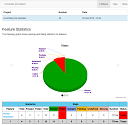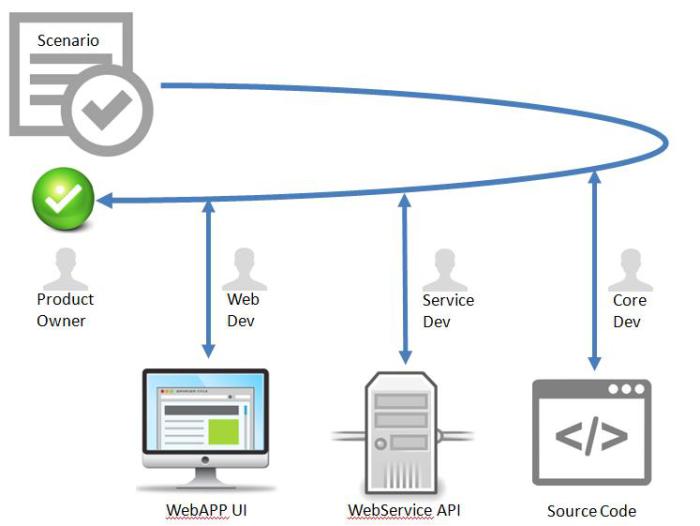
An example of unified code to reuse the same functional test scenario. Over unit tests of the core component code, or exposed API and services, and finally the web application UI.
It’s useful for quality: non-regression test, continous integration, fast feedback, short loop, cost reduction, etc.
Step 1 : Write a Generic Cucumber Scenario
person-repository.feature
Feature: Person Repository
Scenario: Person Creation
Given an empty repository
When I create a new Person named 'George' with the system
Then I should have Person named 'George' in the repository
And give it to developers.

Step 2 : Code a Unit Test for Core Component
RunBDDTest.java
package com.damienfremont.blog;
import org.junit.runner.RunWith;
import cucumber.api.CucumberOptions;
import cucumber.api.junit.Cucumber;
@RunWith(Cucumber.class)
@CucumberOptions(strict = true, features = "../features")
public class RunBDDTest {
}
StepDefinitions.java
package com.damienfremont.blog;
import static org.assertj.core.api.StrictAssertions.assertThat;
import cucumber.api.java8.En;
public class StepDefinitions implements En {
static PersonRepository SYSTEM = new PersonRepository();
public StepDefinitions() {
Given("an empty repository",
() ->
assertThat( SYSTEM.count()).isEqualTo( 0 ));
When("I create a new Person named '(.*)' with the system",
(String name) ->
SYSTEM.create( new PersonModel(name)));
Then("I should have Person named '(.*)' in the repository",
(String name) ->
assertThat(SYSTEM.read(name)).isNotNull());
}
}
Step 3 : Code API Test with REST client
RunBDDTest.java (the same as before)
EmbeddedServer.java (see previous post)
StepDefinitions.java
package com.damienfremont.blog;
import static com.jayway.restassured.RestAssured.expect;
import static org.hamcrest.Matchers.hasItems;
import static org.hamcrest.Matchers.hasSize;
import com.google.common.base.Throwables;
import cucumber.api.java8.En;
public class StepDefinitions implements En {
private static EmbeddedServer SYSTEM;
public StepDefinitions() {
Given("an empty repository",
() ->
expect()
.statusCode(200)
.body("results", hasSize(0))
.when()
.get("/server/api/person"));
When("I create a new Person named '(.*)' with the system",
(String name) ->
expect()
.statusCode(200)
.given()
.contentType("text/plain")
.content(name)
.when()
.post("/server/api/person"));
Then("I should have Person named '(.*)' in the repository",
(String name) ->
expect()
.statusCode(200)
.body("name", hasItems(name))
.when()
.get("/server/api/person"));
Before(
()-> {
try {
SYSTEM = new EmbeddedServer(8080, "/server");
SYSTEM.start();
} catch (Exception e) {
throw Throwables.propagate(e);
}
});
After(
()-> {
SYSTEM.stop();
});
}
}
Step 4 : Code a Web UI Test with Selenium
RunBDDTest.java (the same as before)
StepDefinitions.java
package com.damienfremont.blog;
import static java.util.concurrent.TimeUnit.SECONDS;
import static org.junit.Assert.assertTrue;
import static org.openqa.selenium.phantomjs.PhantomJSDriverService.PHANTOMJS_EXECUTABLE_PATH_PROPERTY;
import org.openqa.selenium.By;
import org.openqa.selenium.WebDriver;
import org.openqa.selenium.phantomjs.PhantomJSDriver;
import org.openqa.selenium.remote.DesiredCapabilities;
import com.google.common.base.Throwables;
import com.google.common.collect.ImmutableMap;
import cucumber.api.java8.En;
public class StepDefinitions implements En {
private static EmbeddedServer server;
private static WebDriver driver;
public StepDefinitions() {
Given("an empty repository",
() -> {
driver.get("http://localhost:8080/server");
assertTrue(driver.findElement(By.cssSelector(
"#message"))
.getText().contains("0 items"));
assertTrue(driver.findElement(By.cssSelector(
"#items"))
.getText().isEmpty());
});
When("I create a new Person named '(.*)' with the system",
(String name) ->{
driver.get("http://localhost:8080/server");
driver.findElement(By.cssSelector(
"#newItem"))
.sendKeys(name);
driver.findElement(By.cssSelector(
"#newButton"))
.click();
});
Then("I should have Person named '(.*)' in the repository",
(String name) ->{
driver.get("http://localhost:8080/server");
assertTrue(driver.findElement(By.cssSelector(
"#message"))
.getText().contains("1 items"));
assertTrue(driver.findElement(By.cssSelector(
"#items"))
.getText().contains(name));
});
Before(
()-> {
// INIT WEB SERVER (TOMCAT)
try {
server = new EmbeddedServer(8080, "/server");
server.start();
} catch (Exception e) {
throw Throwables.propagate(e);
}
// INIT WEB BROWSER (SELENIUM + PHANTOMJS)
driver = new PhantomJSDriver(
new DesiredCapabilities(ImmutableMap.of( //
PHANTOMJS_EXECUTABLE_PATH_PROPERTY, //
new PhantomJsDownloader().downloadAndExtract()
.getAbsolutePath())));
driver.manage().timeouts().implicitlyWait(5, SECONDS);
});
After(
()-> {
server.stop();
});
}
}
Demo
Test Core Layer
Testing that core component:
class PersonRepository {
PersonModel create(PersonModel entity) ...
List<PersonModel> readAll() ...
}
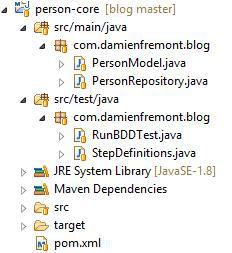
with this project:
And launching RunBDDTest.java with JUnit:
0.026 sec (test) + 0.2 sec (startup)
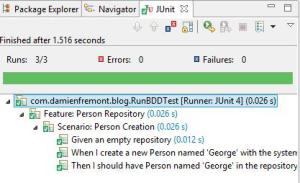
Test Service Layer
Testing that service API:
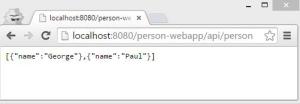
with this project:
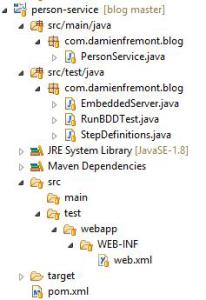
And launching RunBDDTest.java with JUnit:
0.210 sec (test) + 3 sec (startup)

Test WebApp Layer
Testing that web UI:
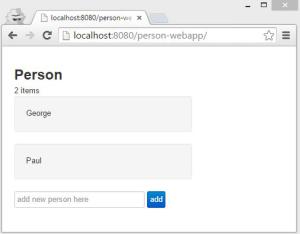
with this project:
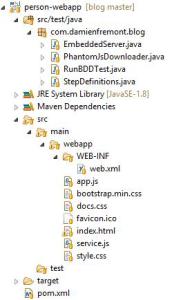
And launching RunBDDTest.java with JUnit:
0.628 sec (test) + 7 sec (startup)
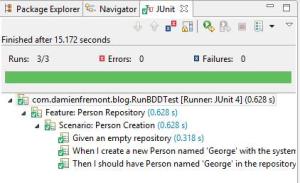
Project Layout Example
A common feature file and maven sub-projects
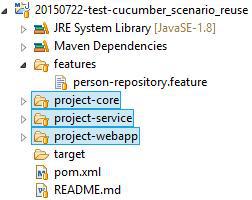
Maven pom.xml
<?xml version="1.0" encoding="UTF-8"?>
<project xmlns="http://maven.apache.org/POM/4.0.0" xmlns:xsi="http://www.w3.org/2001/XMLSchema-instance" xsi:schemaLocation="http://maven.apache.org/POM/4.0.0 http://maven.apache.org/xsd/maven-4.0.0.xsd">
<modelVersion>4.0.0</modelVersion>
<groupId>com.damienfremont.blog</groupId>
<artifactId>20150722-test-cucumber_scenario_reuse</artifactId>
<version>0.0.1-SNAPSHOT</version>
<packaging>pom</packaging>
<modules>
<module>project-core</module>
<module>project-service</module>
<module>project-webapp</module>
</modules>
<dependencies>
<dependency>
<groupId>com.google.guava</groupId>
<artifactId>guava</artifactId>
<version>18.0</version>
</dependency>
<dependency>
<groupId>junit</groupId>
<artifactId>junit</artifactId>
<version>4.12</version>
<scope>test</scope>
</dependency>
<dependency>
<groupId>org.assertj</groupId>
<artifactId>assertj-core</artifactId>
<version>3.1.0</version>
<scope>test</scope>
</dependency>
<dependency>
<groupId>info.cukes</groupId>
<artifactId>cucumber-junit</artifactId>
<version>1.2.3</version>
<scope>test</scope>
</dependency>
<dependency>
<groupId>info.cukes</groupId>
<artifactId>cucumber-java8</artifactId>
<version>1.2.3</version>
<scope>test</scope>
</dependency>
</dependencies>
<build>
<plugins>
<plugin>
<groupId>org.apache.maven.plugins</groupId>
<artifactId>maven-compiler-plugin</artifactId>
<configuration>
<source>1.8</source>
<target>1.8</target>
</configuration>
</plugin>
</plugins>
</build>
</project>
And launching all tests with Maven:
17 sec
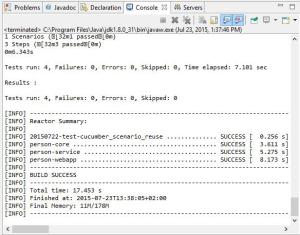
Source
https://github.com/DamienFremont/damienfremont.com-blog-labs/tree/master/20150722-test-cucumber_scenario_reuse https://github.com/DamienFremont/damienfremont.com-blog-labs/tree/master/20150722-test-cucumber_scenario_reuse
References
http://jlunaquiroga.blogspot.fr/2014/01/restful-web-services-with-jetty-and.html http://jlunaquiroga.blogspot.fr/2014/01/restful-web-services-with-jetty-and.html
http://zsoltfabok.com/blog/2012/08/embedded-web-services-for-testing/ http://zsoltfabok.com/blog/2012/08/embedded-web-services-for-testing/
https://github.com/tastejs/todomvc/tree/gh-pages/examples/vanillajs https://github.com/tastejs/todomvc/tree/gh-pages/examples/vanillajs






